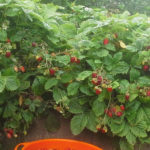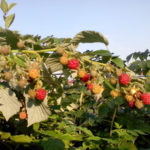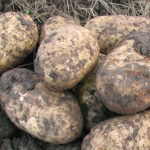Potato variety Latona
Latona is an early maturing potato variety (Solanum tuberosum) of Dutch selection. Bred in the early 90s by the specialists of the HZPC Holland B.V. company. In 1996 he was included in the state register of plants of the Russian Federation. Approved for cultivation in three regions: North-West, Central, Central Chernozem. Suitable for mechanical cleaning and transportation. Suitable for cultivation in temperate climates.

The period from germination to harvest is 65-80 days, the first digging can be done on the 45th day.
The plant is tall, erect, spreading, with an abundant amount of green mass. Potato leaves are dark green in color. Corolla white, moderate flowering. In the process of maturation, the wilting of the tops occurs slowly, the stems do not fit on the ground and do not turn yellow by the end of the growing season.
The root system of Latona is well developed, 10-15 tubers with an average weight of 85-135 grams are formed on one plant. They have an oval-rounded shape and a flat surface without bumps and potholes. The peel is smooth, strong, yellow in color, does not darken during heat treatment. The cut flesh is light yellow in color. The eyes are small, few in number, and shallow.
According to state tests, the marketable yield averages 291-300 c / ha, 109 c / ha more than Pushkinets. At the first digging, on the 45th day after full germination, it is possible to collect 135-241 c / ha, which is 1.2-1.4 times higher than the established standard. The maximum amount was obtained in the Leningrad region - 462 c / ha, 164 c / ha higher than the standards. By the way, the variety has earned special attention precisely due to the high return on early marketable products. Thus, it is ideal for growing to obtain young potatoes for sale or personal consumption. The marketability of tubers is 83−95%, keeping quality is noted at 90%, subject to the storage rules, which we will talk about below.
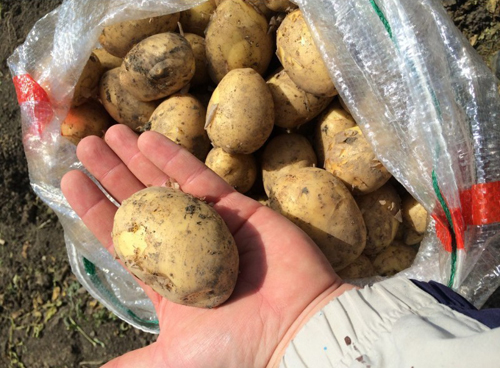
The taste is very good, even excellent. The tubers are medium-sized, do not lose their shape when finished, and also have a pleasant light yellow color. The pulp is rather crumbly, not watery, the starch content in it is 12-15.8%, 2.8% more than the standard. Latona is suitable for preparing a wide variety of dishes, suitable for frying, baking, cooking, stuffing, perfectly complements salads, soups and vegetable mixes. Many gardeners especially appreciate our hero in the form of mashed potatoes - it turns out to be very rich, with an expressive "potato" taste and aroma.
Plants are quite demanding on soil fertility and climatic conditions of growth, however, with proper care and proper agricultural technology, they are capable of producing a large amount of harvest on poor soils, in northern latitudes. In general, this variety is unpretentious and does not require special attention to itself, but there are some subtleties of growing.
- Before planting, standard activities such as tubers selection, calibration and dressing should be carried out. You can also treat them with growth stimulants.
- It is better to plant in early to mid-May, in the soil warmed up to + 10−12 ° С.
- For this potato variety, it is very important to observe crop rotation, since it is susceptible to late blight by tops. Do not plant tubers in an area where other nightshades have previously grown. The best predecessors will be green manure, cabbage, onion, cucumber, garlic, zucchini, legumes, beets.
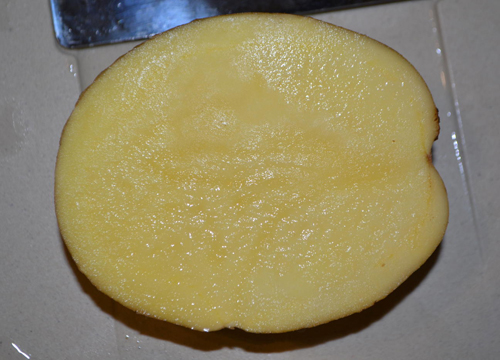
- Plants tolerate both drought and waterlogging well, but a sharp change in these extremes can lead to sad consequences. Therefore, Latona should be provided with timely watering. In the southern latitudes, this needs to be paid great attention, but in the northern latitudes, frequent irrigation is not required.
- Do not forget about standard agricultural techniques, such as loosening the soil, hilling, destroying weeds, and treating diseases and pests with drugs. Also, do not neglect feeding if necessary - the plants respond very well to them.
- Replace seed material in time to avoid tuber degeneration.
There is another feature of the cultivar's agricultural technology, which is more relevant for industrial cultivation areas. When carrying out desiccation (drying plants with chemicals before harvesting), it is important to observe the digging time. If the tubers remain in the soil for a long time after this event, their peel can become very coarse.
After harvesting, it is important to take care of good drying of the tubers for their best preservation. First, the potatoes must be dried under a canopy, in a well-ventilated place, then you can transfer them to a specially prepared storage room and dry them for at least 10 days. If, for some reason, the tubers ended up in storage in a rather damp form, it is extremely important to take measures to dry them as soon as possible in order to avoid condensation and, as a result, damage to the crop.

Latona is resistant to golden cyst nematodes, viruses A and Y, cancer, is rarely affected by ring and dry rot, as well as common scab. It is relatively resistant to late blight of tubers, but the tops are quite susceptible to it, as already mentioned.
This variety has proven itself very well in garden plots and production areas, has a large number of positive reviews. Its stable high yield, early amicable ripening, excellent taste, and unpretentious care are especially appreciated. According to gardeners, potatoes are very resistant to degeneration, for more than 10 years they continue to retain their characteristics and qualities. The reliability of our hero is also noted - in the worst seasons, he does not reduce the yield indicators, while other varieties on the site noticeably lag behind him. The adaptation of plants to any weather conditions was also noticed, be it droughts or heavy rains.
The disadvantage is the susceptibility of tops to late blight. It should also be mentioned that, although tuberization differs in early terms, it is still better to dig after full maturation. By the end of the growing season, the tubers will have time to gain a large mass and good size. Otherwise, for a rather long period of existence, Latona has not been found to have any drawbacks. It is renowned for its reliability, so by choosing it, you obviously won't go wrong!
In Russia, the following enterprises are officially engaged in cultivating the variety: ZAO Oktyabrskoe in the Leningrad Region, FGBUN Federal Research Center Kazan Scientific Center of the Russian Academy of Sciences in Tatarstan, ZAO Teplichny in the Omsk Region, OOO Greenhouse and Greenhouse Plant "Elite-potato" "in Omsk, ETK" Meristemnye kultury "LLC in the Stavropol Territory," Prinevskoye "breeding plant" CJSC "in the Leningrad region. A. G. Lorkha "in the Moscow region.
